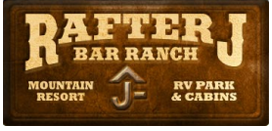In 1874, General George A. Custer's Expedition traveled through the Black hills...
after rumors of gold being discovered near present day Custer. General Custer had a photographer, W.H. Illingworth, along to document his adventures through the Black hills. The Custer military expedition, passed thru Rafter J Bar Ranch, one night in July of 1874.
During the gold rush that followed Custer’s expedition, Rafter J Bar Ranch became one of the stage coach stops along the Cheyenne to Deadwood trail.
At the time, it was estimated to be 12 miles from Custer city, being referred to as either the 12 or 11 mile station. Due to its location near spring creek, Rafter J Bar Ranch also had the nick name: “Spring Creek Station”.
The original barn and stable used for the Deadwood State Coach operations are the very one you can still see and visit at the historic location today.
A total of three buildings were built for the stage coach stop. The north side of this barn (which included a saloon), the log cabin on the west side (which was at one time a café) and the owner’s cabin (modernized with white siding).
During the Black Hills gold rush, the Deadwood Stage route was a gateway into South Dakota from Cheyenne, Denver and numerous west coast cities. Stage coaches carried thousands of passengers, freight and millions of dollars worth of gold to and from the Black hills to Cheyenne, Wyoming.
The trail led to the hope of gold, adventure and riches in the Black Hills. But to some, these dreams came with a high price. The route had dangerous encounters with Indian attacks, hold ups by bandits, and treacherous blizzards in the winter.
In 1886, the 160 acres of land became the Walker Placer Mining Claim. Even today, there still lie mining tunnels and shafts around the perimeter of the property in the national forest. The stage coach came to an end when the railroad began, but the Walker Family continued to homestead. The railroad was built up to Hill City, also known as ‘Hillyo’, in 1893. The current George S. Mickelson hiking/biking trail on the edge of the property is where the railroad was located.
When the homesteading began, the Rafter J Bar brand began to be used, and the Rafter J Bar Ranch was born. It continued to operate as a ranch until 1964, when the Bob Higgins Family began to develop it into a campground.
In 1970, the George Family bought the property and has continued to further develop the ranch into what has become the resort today.
“While the thrill may lie in the hunt, it is also the moment you discover an expedition photograph site for yourself or realize you are walking the same piece of earth as soldiers, scouts, teamsters, and cooks who first explored the Black Hills in 1874. To see the same tree stump Illingworth saw, or the same rock lying on the forest floor, or a dim rut where Custer’s wagons passed by is a truly unique way of connecting with the past. We call it ‘standing in history’.


